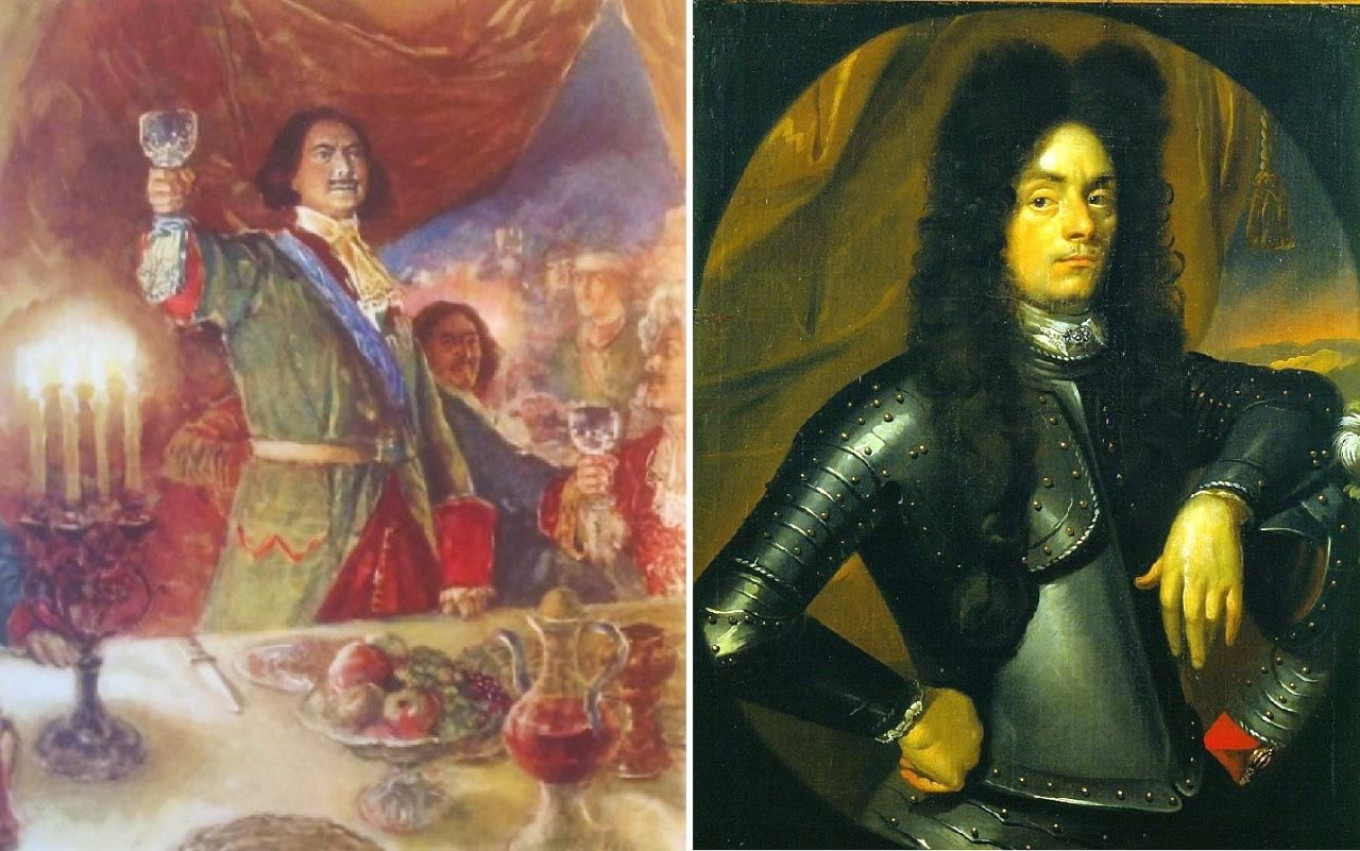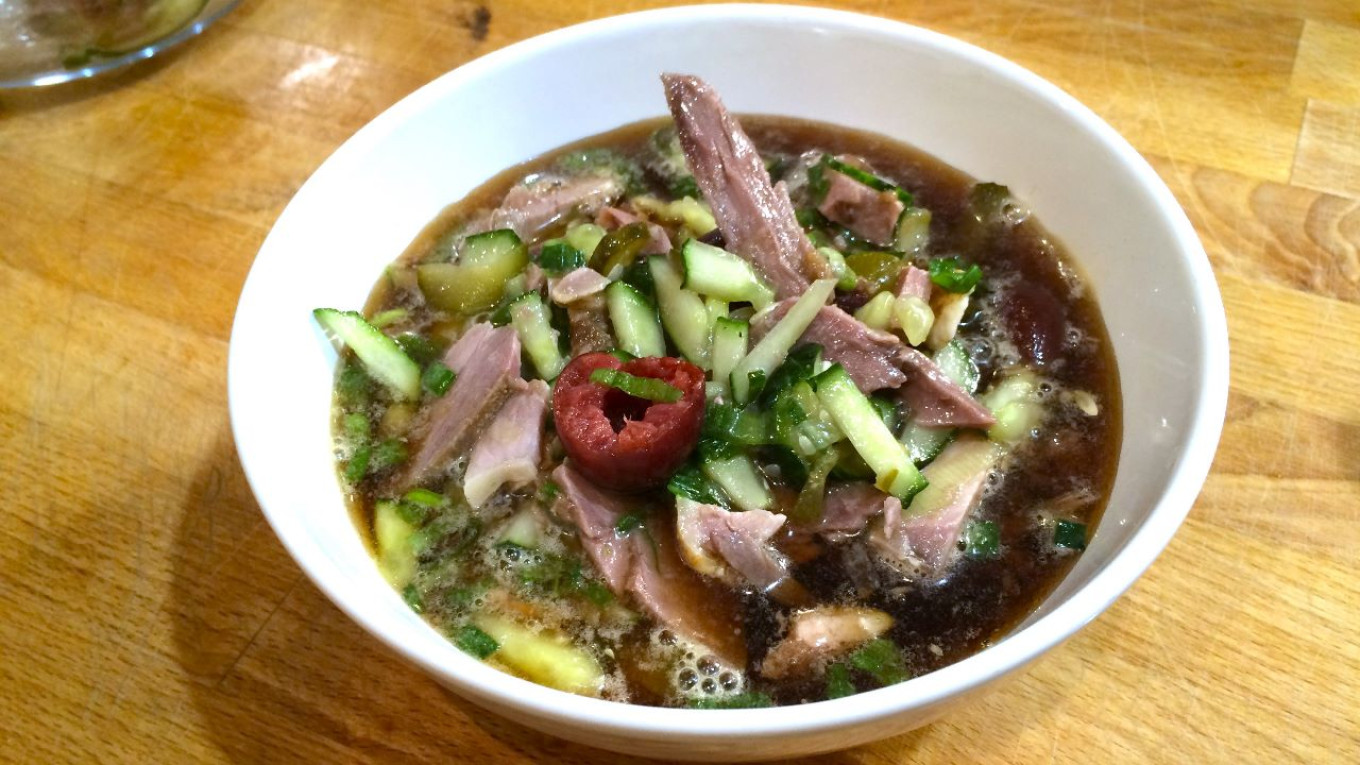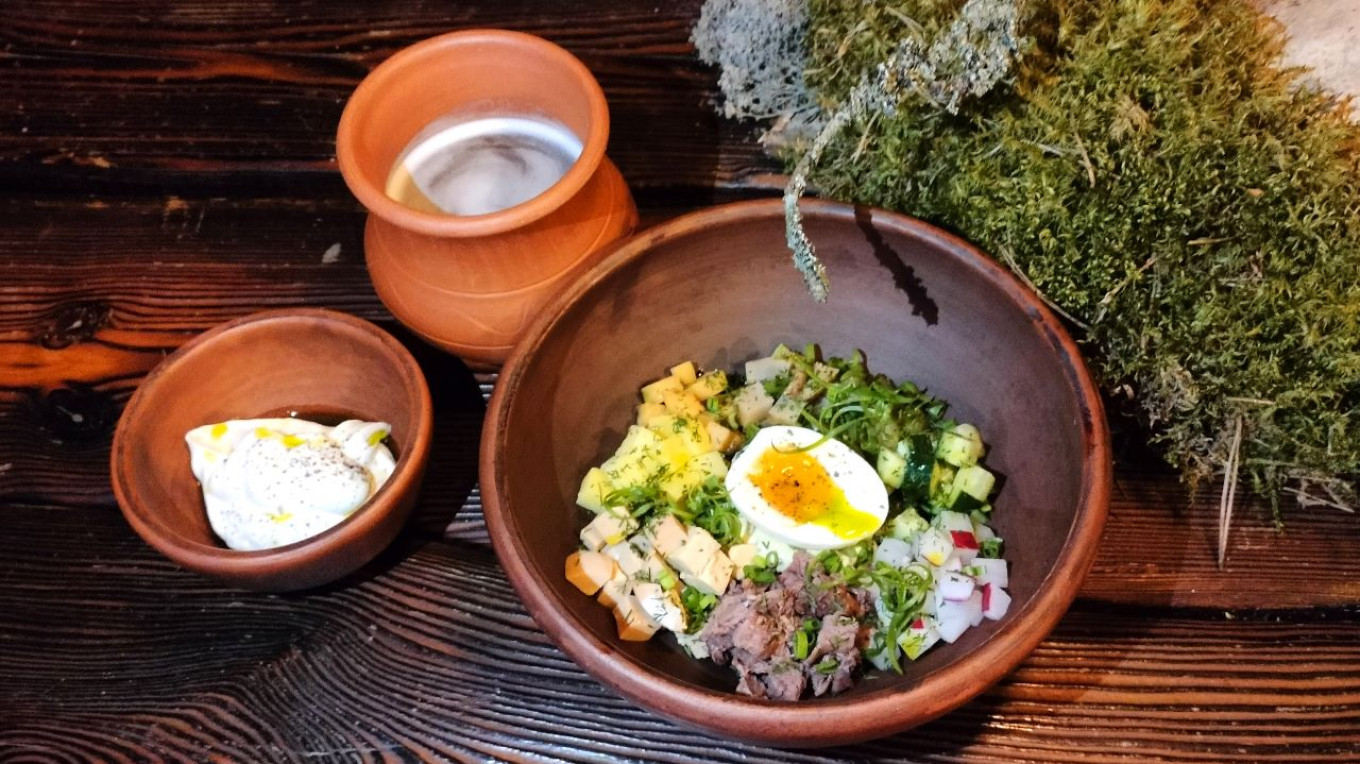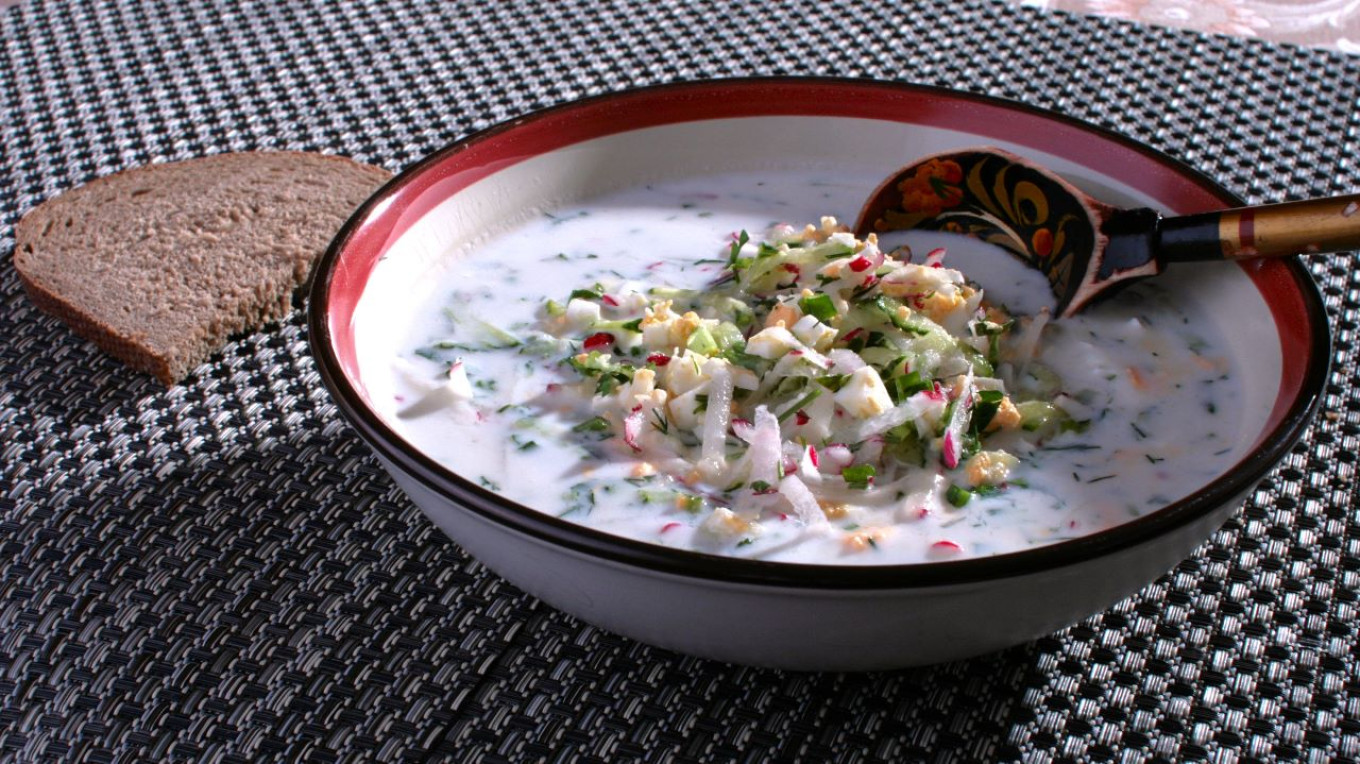In Russia people have been arguing about what to use in okroshka — kvas or kefir — for a hundred years. But before that they were arguing about something else. Should salted plums be added? Is it better to add bits of shredded grouse or pork? What about adding sprat in tomato sauce?
The word "okroshka" is quite ancient and comes from a word for a hodge-podge. Unfortunately, Russian cooks were not in the habit of writing down recipes. So we will not find any mention of okroshka in annals written millennia ago. But, for example, in the 18th century Danish ambassador Just Juel wrote that at the court of Peter I they served a soup made from beer vinegar with finely chopped onions and peppers. Most likely the foreigner simply did not understand and called kvas "beer vinegar."
"Food was on the table and he invited me to dine with him. I agreed, but I had never had such a bad meal in my life. Because it was Lent there was nothing on the table but sturgeon, sterlet, and other species unknown in Denmark that reeked of blubber [rendered fat of whales, walrus, or seals]. In addition, all the viands were seasoned with peppers and onions. Among the dishes was a soup made of beer vinegar (oellviineddicke), finely chopped onions and pepper."

What was "beer vinegar" as understood by a European traveler in the early 18th-century? Of course, one can assume that it really was vinegar (in Russia it was made from beer wort, not from wine). But it's hard to believe our ancestors enjoyed chowder made of fish and vinegar, or that this vinegar "soup" could be boiled. So it is more likely it was kvas, a beverage Europeans didn’t know and tried to "translate" into their language as best they could.
Today we know that okroshka is the most common summer dish made from kvas. But has it always been as we know it now?
The first recipe for okroshka is in Nikolai Osipov's “The Old Russian Hostess, Housekeeper and Kitchen Maid (1790): "Chop finely different roast meats with onions, cucumbers and sour cream; salt it and pour in cucumber brine, or kvas, or sour cabbage soup broth."
Almost at the same time, a recipe also appears in "Russian Cookery" by Vasily Lyovshin (1795-1798). In the section "Russian cooking" we find a version of okroshka that is more familiar:
"It is made from various leftover roasted meats — wild and domestic foul and other meat — but the best for this recipe is turkey, grouse and piglet. Pull the meat off the bones, finely shred with raw onion, fresh or pickled cucumbers; add pickled plums cut from the pits; mix all together again, mash with a spoon, moisten with cucumber or plum pickle brine or vinegar; let stand, then pour kvas over it and serve.”

The key is the use of roasted meat, that is, pre-cooked ingredients. Fish was used the same way: it had to be boiled or fried beforehand. Vegetables were also boiled or stewed.
The only mystery was the use of vinegar. Today it seems rather exotic. But let's not forget that we are talking about medieval cuisine.
Okroshka is a summer dish, which means that the meat and fish used in it could not be stored for long in the heat. A cook could roast slices of beef for the okroshka. But how many people were fortunate to have fresh beef on hand? Cows were usually slaughtered in the fall when cold okroshka was no longer put on the table. In spring and summer people used corned beef, which was the only way to preserve meat before the invention of refrigerators.
But corned beef is tough and sometimes has an unpleasant odor since the meat was salted unevenly. Today we know how this is handled. In stores they add vinegar to ready-made shish kebab meat to solve the problem — and buyers don’t even know that the meat is rather old. Cooks used the same process way back then. Hence the vinegar in eighteenth-century okroshka.
So what changed in the next century? The way meat was sold. In large city markets "fresh meat" replaced "corned meat" all year round. Fresh meat became available to Russians beginning in the 1820s and 1830s. And if a hundred or two hundred years before that foreign travelers complained that when trying to buy a couple of pounds of beef they were told they had to buy a whole cow, in the early 19th century everything changed. And it became less common to tenderize and "finish" meat with vinegar. So in cookbooks of that time, it is not added to recipes for okroshka. For example, Yekaterina Avdeyeva in her "Handbook for the Experienced Housewife” (1842) does not even mention it:
"Okroshka: Use the remainder of a roast, whatever you have on hand (except for piglet and pork, which are no good because they are too fatty), cut in small pieces, chop green onions, dill, cucumbers, hard boiled eggs, and crayfish necks if you have any on hand. Mix all together, pour in good kvas, salt and let stand. If you like, you can add two spoons of fresh sour cream.”

Despite its simplicity, okroshka became part of refined Russian cuisine. It was on the menu of the English Club in Moscow and even served at a formal reception at the Palace in St. Petersburg. This is confirmed by a recipe from Ignatius Radetzky's book “St. Petersburg Cuisine,” published in 1862, which was something of a chronicle of the capital's finest cooking at the time.
Lenten Okroshka (Okrochka maigre à la russe)
“Clean and cut a salpicon of the following: cucumbers, fresh or salted; pickled cucumbers; boiled or pickled porcini mushrooms, salted milk mushrooms, milk caps and saffron milk caps; fresh or pickled apples (you can substitute plums, cherries, peaches and dried grapes); boiled and peeled potatoes, beets, and green beans. Put everything in a soup bowl. Before serving, grind a bit of cooked black mustard and salt, pour a few drops of olive oil in and stir constantly so that the oil and mustard turn into a thick sauce. Dilute it gradually with sour cabbage soup broth or good kvas, add salt and pepper to taste, garnish with chopped green onions or shallots, parsley, tarragon, chervil and dill. Pour the mixture in a soup bowl and serve iced.”
It should also be remembered that similar dishes exist in Belarusian, Polish, and Baltic cuisines. In Belarus, is is traditionally called "khaladnik" or "mishanina." Poland has its own shłodnik, and in Lithuania it is šaltibarščiai.
In some places it is made with kvas (including beet kvas); in other places it is made with beet or sorrel broth and milk — or with kefir, as in today’s recipe. The memoirist Vasily Insarsky wrote in "Old Days in Russia" in 1904, "On the hottest days at dinner there was always okroshka, or kholodnik done the “Malorossian” way, which the prince always praised and liked to describe how it was invented.” So you see it would be more correct to speak about "invention" of okroshka by several nations at once.
In Russia several different variants of okroshka were “invented.” In the Saratov region in the 19th century kvas was poured over a piece of beef jelly with chopped onions in a bowl. The beef jelly fell apart to produce a meat-flavored cold soup.
An unusual okroshka was made in the Vladimir region. In the middle of the 20th century there was a popular okroshka made with canned fish — sprats in tomato sauce. Sprats were put in a bowl with cucumbers, herbs and onions, and then kvas was poured over it all. At the time it was impossible to buy meat in village stores, so canned sprats were used instead.
In general, okroshka was the perfect dish for Soviet reality. In the 1960s people began to chop and add luncheon meat or good quality hot dogs. About that time the tradition of using fried ingredients disappeared. And finally, the apotheosis of Soviet okroshka: kefir. The fashion for making okroshka with kefir is from the late Soviet era.
Today, the question of whether to make okroshka with kefir or kvas has divided Russians almost equally. Sometimes the ferocity of the kefir vs. kvas argument gets out of hand, and people joke that it is like Biblical times, when “brother turns on brother and son on father.”
But we think both options are delicious. In our kitchen we serve okroshko with both kvas and kefir.

Kefir Okroshka
Ingredients
- 1 liter (generous quart) of cold 2.5% fat kefir
- 250-300 ml (1 – 1 ¼ c) cold sparkling water
- 2 medium potatoes
- 3 eggs
- 200 g (7 oz) ham or baloney (luncheon meat)
- 150 g (5 oz) fresh cucumber
- 100 g (3.5 oz) radish
- 6 sprigs dill
- 4 stalks green onions
- 1 Tbsp grated horseradish or hot Russian mustard
- salt - to taste
Instructions
- Wash the potatoes, boil them in jackets until tender. Cool, peel the potatoes.
- Boil the eggs until cooked through. Let cool, peel.
- Wash and dry cucumbers, radishes and greens.
- Chop dill and herbs and put them in the bowl or pitcher that you’ll serve the okroshka in. It must not be made of aluminum.
- Add a pinch of salt to the greens and lightly crush them with a spoon.
- Grate cucumbers and radishes on a coarse grater and add to the greens. If desired, you can cut the vegetables into cubes or julienne strips. Cucumbers with rough skin should be peeled.
- Dice or shred the eggs, potatoes and ham and add to the vegetables and herbs.
- Add the kefir and sparkling water.
- Add salt, horseradish or mustard to taste. Stir to combine.
- You can serve the okroshka at once or leave it in the refrigerator for 1 hour.
A Message from The Moscow Times:
Dear readers,
We are facing unprecedented challenges. Russia's Prosecutor General's Office has designated The Moscow Times as an "undesirable" organization, criminalizing our work and putting our staff at risk of prosecution. This follows our earlier unjust labeling as a "foreign agent."
These actions are direct attempts to silence independent journalism in Russia. The authorities claim our work "discredits the decisions of the Russian leadership." We see things differently: we strive to provide accurate, unbiased reporting on Russia.
We, the journalists of The Moscow Times, refuse to be silenced. But to continue our work, we need your help.
Your support, no matter how small, makes a world of difference. If you can, please support us monthly starting from just $2. It's quick to set up, and every contribution makes a significant impact.
By supporting The Moscow Times, you're defending open, independent journalism in the face of repression. Thank you for standing with us.
Remind me later.







